

By Lora Koenig and Jessica Williams
Hi, this is Lora. Sorry for not blogging for the past week or so but wow, we have been busy! On 17 November, I left my home in Silver Spring, MD, and spent 32 hours in transit before arriving in Christchurch, New Zealand. I flew from Regan National Airport to Chicago, and then took a flight to Los Angeles. In L.A. I joined the entire team (Clem, Ludo, Michelle, Jessica and Randy) for the long flight to Auckland, New Zealand. In Auckland we cleared customs and hopped on another plane to Christchurch, New Zealand. All United States Antarctic Program (USAP) participants use a special bag tag for our luggage with a penguin. The bag tags are different colors depending on the year, but the penguin is always the same. If you ever see a bag with a penguin tag at an airport, it means its owner is about to start his or her trip to Antarctica.

We all arrived Christchurch in the afternoon on Nov 19th. We were tired but needed to stay up and adjust to the time frame, so we went for a walk. Christchurch suffered a large earthquake last year and much of the city is still inaccessible. For those of us that have been there before, it was very sad to see the devastation but it was also hopeful to observe new businesses sprouting up in containers around the city. Yes, I said containers: in Christchurch, they have modified shipping containers to make nice, modern looking storefronts and coffees shops.
Our time in Christchurch was short. On Sunday, 20 November, we picked up all of our cold weather gear. I will let Jessica tell you more about that.
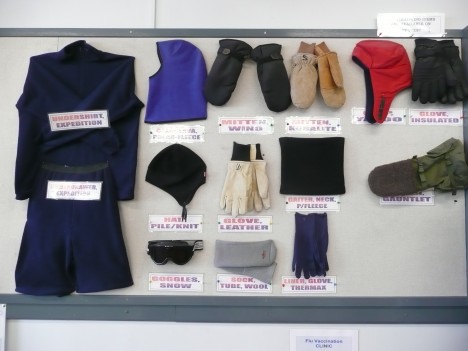
Jessica here. As Lora was explaining, on Sunday we went to the Antarctica Clothing Distribution Center (CDC) to pick up all of our extreme cold weather gear (we call it ECW gear for short). When we arrived, the CDC people did a brief orientation for the new participants, describing the gear we would be using and how to choose the proper clothing sizes.

Afterward, we separated into the respective changing rooms (male or female), where the CDC staff had already set aside the basic ECW gear for everyone based on the height, weight, and other sizing information we gave them in applying for the program. It was pretty crazy trying on all of the clothes and making sure all of the layers fit and then changing the items that didn’t. Everybody wanted to do this properly so when we were out in the field our clothes would fit, but at the same time we were all trying to get through it quickly so we could go back in town and do other things. As it is my first time deploying to Antarctica, I was extremely grateful that the other two female members of our team (Michelle and Lora) had already been there. They knew what types of clothing were better, what layers they used and which ones they didn’t, what extra gear we should request since we are going to the deep field, and what gear we should have brought with us to supplement the CDC gear.
I got the bunny boots because they ran out of larger boot sizes in the blue FDX boots. I think everybody else got the FDX boots.
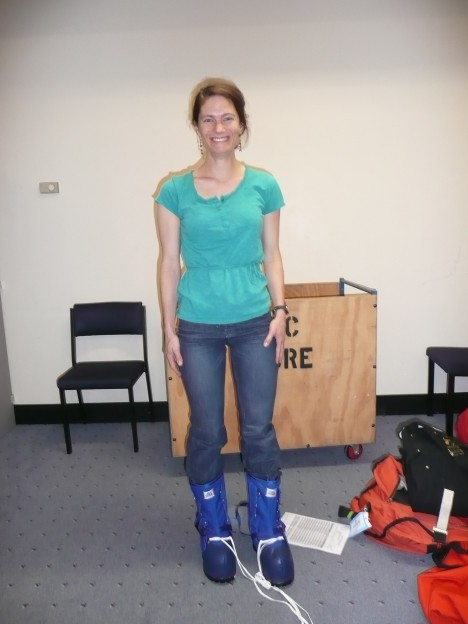
The bunny boots are extremely warm but they don’t have the best traction; however, using yaktrax, the bunny boots will work great. Additionally, we got these extra snowmits that aren’t issued for everyone but are very useful when traveling on the snowmobiles. The rest of the gear was just your typical winter clothing — lots of synthetic layers. A couple pairs of long thermals (lightweight and polar weight), some fleece layers, plenty of glove liners and gloves, hats and balaclavas, wind pants, wind jacket, and lastly, the infamous big red parka. The big reds are HUGE, they have at least 14 pockets (I am still finding new ones) and are rather bulky, but they are extremely warm (definitely a necessity in Antarctica). Overall, I think we all got the gear we wanted in the sizes we needed, so we should all be nice and toasty on our traverse across Antarctica.
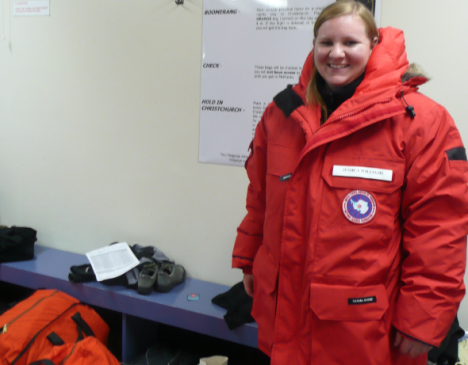
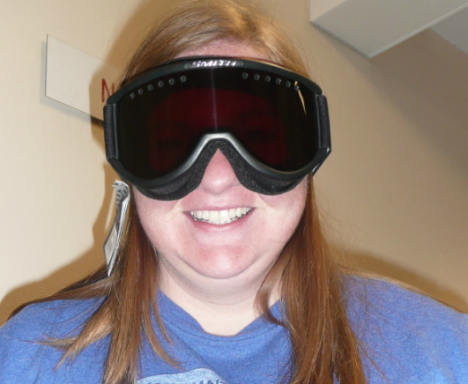
This is Lora again. At 4:30 AM on Monday, 21 November, we left our hotel for our flight to Antarctica. We got to the USAP passenger terminal and had our morning briefing, where we were told that there would be some VIPs on our plane: the king of Malaysia and his entourage were traveling with us to Antarctica. It is not that uncommon to meet VIPs on ice sheets: rising sea levels already are and are becoming real problems for many nations, and many of them are considering mitigation efforts. Government officials often visit the ice sheets to see the effects of climate change first hand. Having the king on board sure made for an exciting flight, although we were requested not to take pictures when the king was around.
We all boarded a C-17 plane and took off around 8:00 am. We landed in Antarctica about 1:00 pm to a rather foggy but warm day. I will let the rest of the team tell you more about our time in McMurdo and what it feels like to be in Antarctica in our next post.
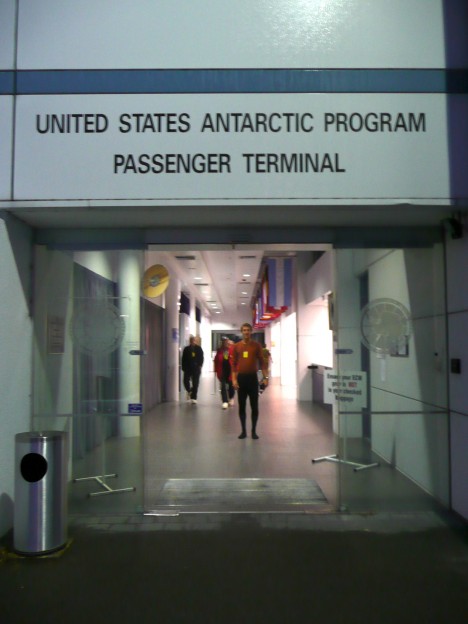
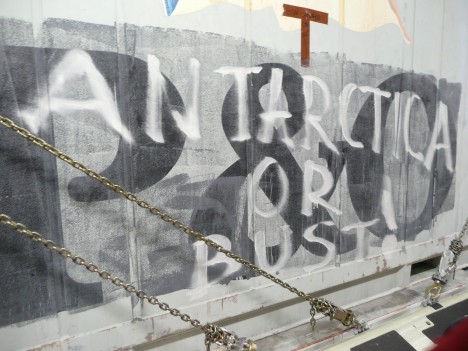
By Lora Koenig
Yesterday was an exciting day in the office. While I was downloading satellite data, answering e-mails and tying up loose ends before leaving for Antarctica, I was also closely following the NASA Airborne Sciences Flight Tracker and the flight path of the NASA DC-8 aircraft. The DC-8 is currently flying over Antarctica as part of the Operation IceBridge mission and yesterday it overflew the 2010 SEAT traverse line and ice core drilling sites. (For more detailed info on Operation IceBridge, check out the mission’s website).
I spent part of the day yesterday watching my screen as the flight tracker showed a little green aircraft moving over our 2010 route. Here is the aircraft approaching our line at about 1:40 PM Eastern time. (The tracker was not updating the plane image at this time, but the aircraft was at the end of the red line.)
Here it is halfway through. (Note that the plane does a 270-degree turn to line up on our traverse line to make sure it is leveled as it crosses our 2010 ice core sites. This ensures the best quality of radar data.)
And here is the plane at about 2:35 PM EST, finishing the portion of its flight that retraced our traverse and four ice core locations:
I watched on my screen as the IceBridge plane covered in just less than an hour the same ground that took us 12 days to cover last year.
OK, so I guess you are asking yourself: Why do we go out in the field, in sub-freezing weather, to drive around on snowmobiles for 12 days to do what a plane can do in an hour? Because you can not drill an ice core from an airplane. The airplane carries radars, which provide great spatial coverage of radar data, but we need to calibrate the radar data with the annual cycles we get from ice cores. (See last week’s blog post on how we determine annual cycles in the lab). So, yesterday, IceBridge collected great radar data that will compare to the data from our ice core sites, as well as to data from the WAIS divide ice core and the ice cores collected by a group led by Dr. Ian Joughin at University of Washington.
The IceBridge DC-8 aircraft flies with radars that are nearly identical to the ones we use on the ground. They are named Snow Radar and Ku-band Radar and are built by the Center for Remote Sensing of Ice Sheets, CReSIS. We will use the airborne radar data gathered yesterday to investigate any differences between what the radars are measuring from the air and on the ground.
In a week, we board our flights to Antarctica. After watching the IceBridge plane flying in West Antarctica yesterday, I am even more excited to get my boots on the ice.
By Lora Koenig
Two weeks ago, I traveled to Utah to help the team finalize planning for this season and to visit the ice core lab and our 2010 ice cores at BYU. The entire was there, except for Ludo, who was in Hawaii competing in a triathlon. (Ludo is not only a top scientist but a top triathlete. I hope he is not getting too use to the warm weather because in less than a month he will be facing temperatures around 0°F.)
There were a few tasks to complete in Utah. The first was to look at many different types of satellite data on the region where we will be traveling to make sure there aren’t any crevasses or other dangers along the route. A crevasse is a crack in the ice. As the ice flows (yes, ice flows just like a mound of putty), it can crack when it goes over a bump or accelerates. Here is a recent picture of crevasses in Western Antarctica, from a NASA Operation IceBridge flight.
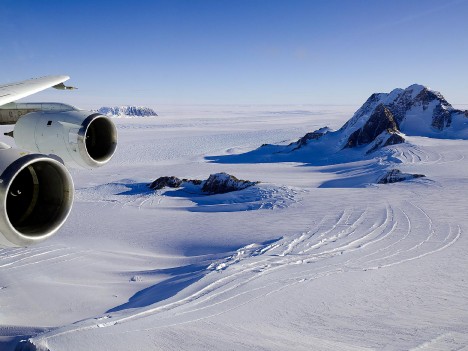
As you can imagine, we would not want to drive a snowmobile in an area like this. So we spent hours looking over maps of the rock bed under the ice sheet to look for bumps, visible and radar satellite images of the surface of the ice sheet, and satellite data showing the velocity of ice flow to make sure that we are traveling on the safest possible route. We ended up moving one ice core drilling location slightly to avoid a dark spot that we could not clearly identify in one of the radar images, just to be extra cautious. Once the route was established, we generated waypoints (coordinates) every kilometer to load into the GPS units that we will use for navigation. The place we are going to is big, white and flat: It is very easy to lose your sense of direction, so we rely heavily on GPS units for navigation.
For some great images and videos on how ice flows in Antarctica please check out this video, made by our NASA colleague Eric Rignot who (thanks again, Eric!) also checked the data that sits behind these videos to help ensure our safe route.
If you would like an in-depth look, this file, which opens on Google Earth, shows our final route with points every 1 km.
Our second task in Utah was to visit last year’s ice cores and have our first meeting to discuss the initial data coming from them. First, here is a picture of a core in the field, taken in December 2010.
In this photo, Michelle (right) is labeling the core and I (left) am getting the core tube ready for storage. The arrow on the ice core bag shows which direction is up. It is very important that all the cores are labeled in order, or we would lose our time series. The metallic tube in the center left of the picture protects the core during shipping. The core in the tube gets placed in the white core box sitting open on the left side of the picture. (Also, notice that Michelle is standing on a bright green pad to help insulate her feet from the cold snow. It’s a veteran trick for keeping your toes warm.)
Here is that same core in the lab today.
Summer is holding what was about 8 feet of the core and the rest of the about 50 feet of core is stacked in the boxes behind her, waiting for analysis.
Here is a very basic explanation of what happens to the cores once they arrive at Summer’s lab at BYU. (Normally, Summer would be the one writing this, but she is currently studying glaciers in Bhutan.)
When the core arrives, we put it in the freezer. Here is Landon peering out of the freezer door:
In the freezer, we weigh the core to determine its density and measure its electrical conductivity, which tells us about its chemical composition. A volcanic event would be detected in the cores by the electrical conductivity and can be used to set a point in time. We take all these measurements twice, or even three times, to make sure they are accurate.
Here is a picture of a core that Landon is preparing, sitting on the freezer’s core handling tray:
This freezer is set to -4°F, so when not posing for a picture, Landon would normally be in a parka with gloves on. As you can see, the core is still in its protective bag, which will be removed when actually processing the core. From here, the core is cut up into sections less than an inch (2 cm) long, and melted for the next stage of analysis.
I will add a quick note here that on last year’s traverse Landon was our lead driller. Both Landon and Jessica are masters students at BYU. They are not only integral players of the field teams, but are also the lead students for the lab analysis of these cores.
Once we have melted the core and put it in a bottle, we send it over to Jessica.
Here is Jessica operating the mass spectrometer (black box to the left in the picture with the blue screen) that will measure the stable water isotopes used to date the core. The isotopes in the snow have an annual cycle and it is this cycle that determines age of the core. An isotope is an atom, in our case an oxygen atom, that has different variations with different number of neutrons and atomic numbers. Oxygen has three stable isotopes: 16O, 17O, and 18O. The peaks and valleys in the ratios of 18O/16O reflect the warmer (summer) and cooler (winter) temperatures, respectively. Once the mass spectrometer determines the number of isotopes, we can establish the age of the core, in a way similar to counting tree rings. During this process, the core is in the little blue vials just to the right of Jessica.
After spending some time in the lab, we looked at the data from the first core that has been analyzed. At this point the density and isotopes have been measured and Summer is carefully working to put together the depth-age scale, which is the age of the core at each depth where the core use to sit in the ice sheet. I will use the density data from the core to determine an age-depth scale from the layers in the radar data and if all goes well the radar and ice core will line up giving us confidence in our analysis.
Last Monday, when I returned to Goddard, I had received my travel itinerary. We will be leaving the U.S. on Nov 17th to make our journey down to Antarctica. With all of this preparation, I am eagerly awaiting getting my feet on the Ice.
By Summer Ruper
Hello SEAT blog followers. I am Summer Ruper, and I would like to share with you a little bit of the ice coring adventure that begins well before the field team heads to Antarctica. Before we start drilling ice cores in the harsh cold and wind of Antarctica, we have to train our field team on the drill and sampling procedures. To do this, we took a trip to a slightly warmer region with ice: Athabasca Glacier in the Columbia Ice Field. Athabasca Glacier is near the Canadian town of Banff, and is one of the most visited glaciers in the world. It’s a beautiful area, and plenty of ice to play with.
To begin, we must first answer the question: What is an ice core? Simply put, it is a core sample collected from a glacier or ice sheet. But the ice core is not entirely made up of ice; with the snow fall and wind also come dust, salts, and even ash from volcanic eruptions. All of this is contained in the ice cores and provides information about how snowfall, temperature, and winds have changed over time. A lot of important information is buried in the ice and snow on glaciers and ice sheets, but you have to get the ice out in order to get at that information.
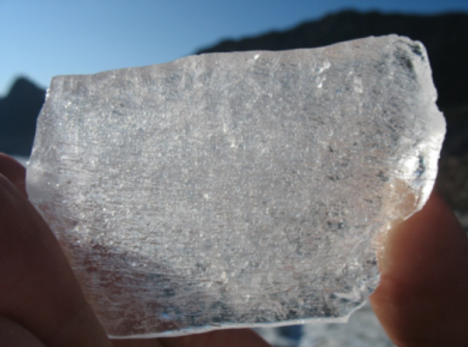
In order to collect the ice cores, we use a specially designed ice core drill. The one we use is called the FELICS, and is designed and manufactured by Felix and Dieter Stampfli in Switzerland. Basically, the drill has a sharp ring on the end that cuts the ice and feeds the core into a one-meter long barrel. We pull the one-meter section up, empty it out of the barrel, and then drill another one-meter ice core from the bottom of the hole. We do this over and over again until we have drilled to a depth of about 20 meters, and have about 20 one-meter long ice cores.

On Athabasca Glacier, our field crew learned how to operate the drill, handle the ice cores, and generally deal with problems that might arise. We were also able to show the tourists visiting that glacier how the drill worked, let them see (and taste) the ice, and share a little of our knowledge and excitement about glaciers and the environmental records contained in the ice. We had a lot of fun, and Jessica and Randy are excited to transfer this experience to our work on the Antarctic ice sheet soon.

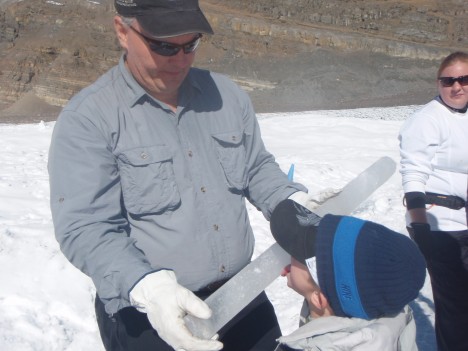
In another post, we will show you what we do with the ice cores once they return to the lab and share some of our preliminary results from last year’s ice cores.
